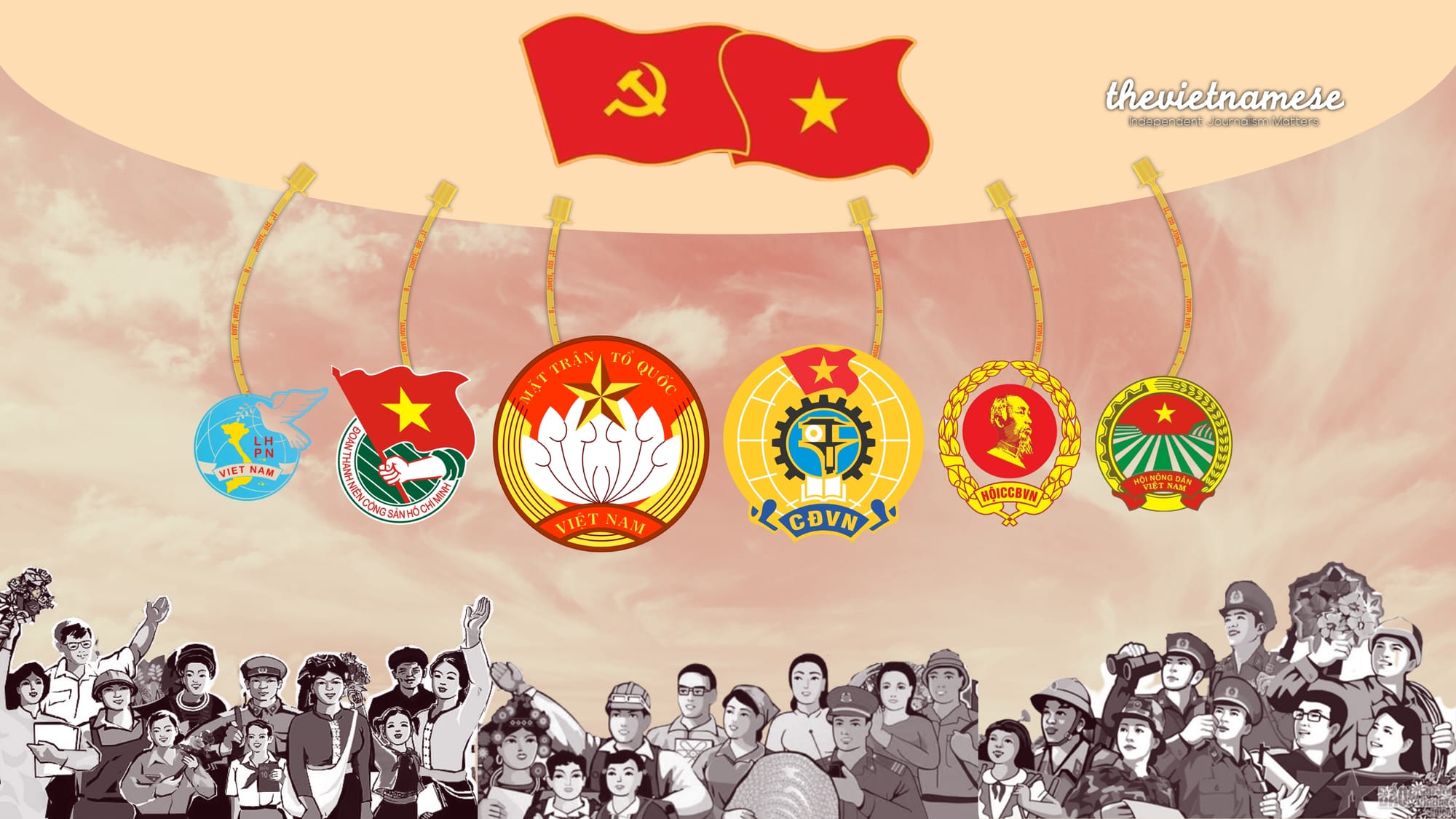Hiếu Mạnh wrote this Vietnamese article, published in Luật Khoa Magazine on March 15, 2025. Thúc Kháng translated it into English for The Vietnamese Magazine.
A frequently occurring phrase in Vietnamese state media is “the extended arm of the Party,” which isoften used to describe the many socio-political organizations and associations that have been granted special status by the Vietnamese Communist Party (VCP).
These groups are often tasked with disseminating propaganda and mobilizing citizens to comply with Party policies or directives. Given the vast VCP membership — now exceeding five million — these organizations and associations are necessary to maintain comprehensive leadership and social control; the VCP needs an “extended arm” that reaches from the central government all the way down to the provincial level.
However, despite receiving an annual budget of trillions of VND and employing fully tenured government staff, these organizations face skepticism regarding their effectiveness.
Six Socio-Political Organizations and 30 Mass Associations
According to the 2013 Constitution, Việt Nam currently has six socio-political organizations: the Việt Nam General Confederation of Labor, the Ho Chi Minh Communist Youth Union, the Việt Nam Women’s Union, the Việt Nam Farmers’ Union, the Việt Nam Veterans Association, and the Việt Nam Fatherland Front. They function at every administrative level, from the central government all the way to local wards and communes.
These organizations are typically responsible for mobilizing the masses, advocating for the rights of specific social groups, participating in policy-making, and overseeing law enforcement.
In addition, under Decision 68 issued by the Prime Minister in 2010, Việt Nam has 28 centrally managed associations that have been granted special status. These 28 special-status associations, along with the Việt Nam Publishing Association and the Việt Nam Bar Federation, are collectively referred to as the 30 mass associations.
The Party assigns these mass associations tasks at the level of the central government and receive state support in staffing and operational funding. They primarily operate in professional fields, humanitarian efforts, and charitable works. These mass associations primarily operate in professional, humanitarian, or charitable fields rather than holding political or leadership roles like the Việt Nam Fatherland Front or the socio-political organizations.
Beyond the six socio-political organizations and 30 mass associations, numerous smaller associations operate at various levels within the Vietnamese government.
According to a 2014 proposal for the Law on Associations, Việt Nam had 52,565 associations at that time, including 483 operating nationwide and 52,082 at the local level. Of these, 8,792 were granted special status.
A study by the Việt Nam Institute for Economic and Policy Research (VEPR) at the University of Economics, Việt Nam National University, Hanoi, found that between 2011 and 2014, socio-political organizations in Việt Nam had approximately 42.5 million members — excluding those affiliated with nationwide mass associations.
Using the National Assembly’s available data from its resolutions on central budget allocation for 2021–2025, Luật Khoa Magazine compiled a table estimating the annual expenditures for the six socio-political organizations and mass associations where the Việt Nam Publishing Association was excluded, but the Việt Nam Union of UNESCO Associations was included at the central level.
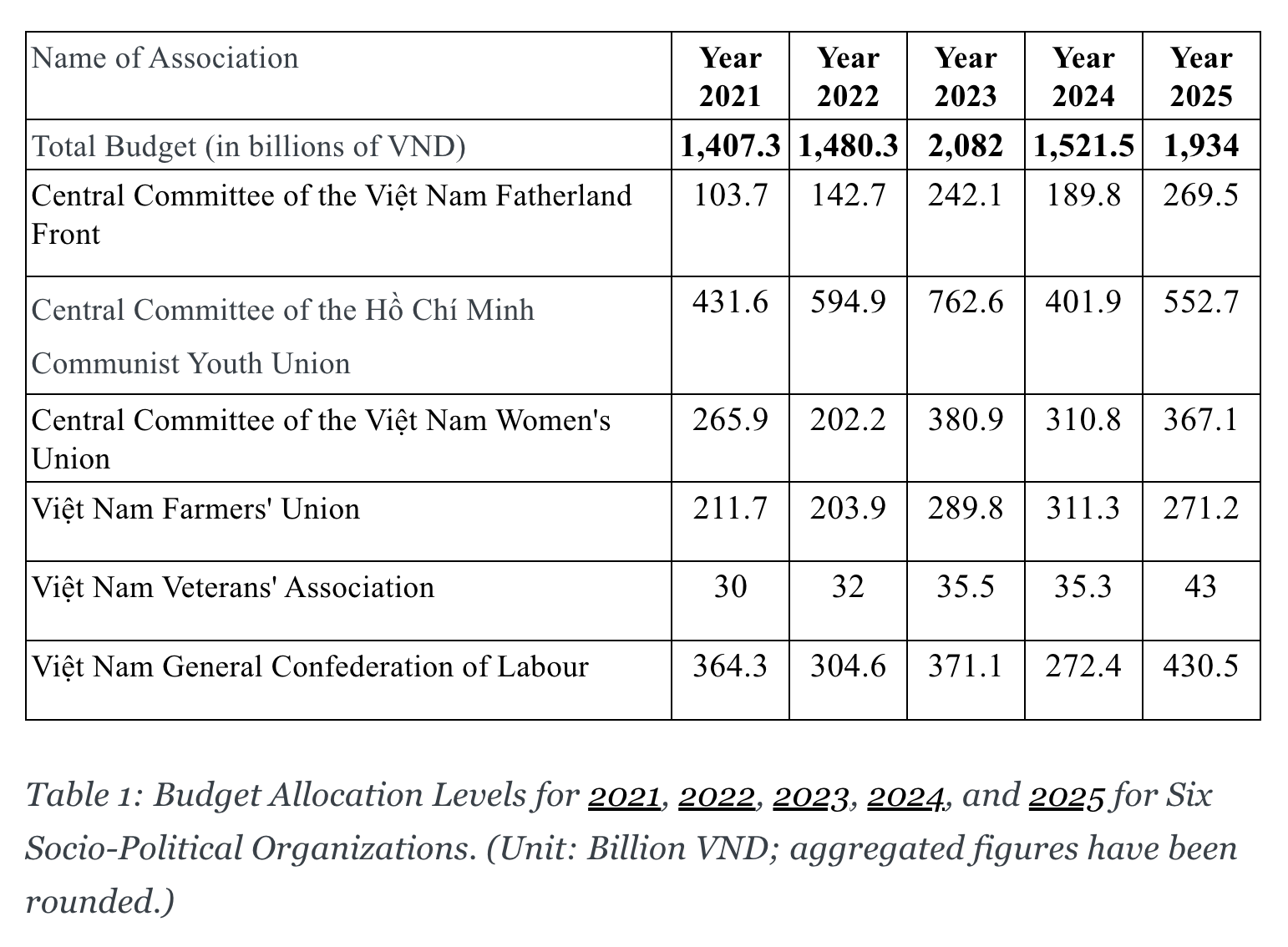
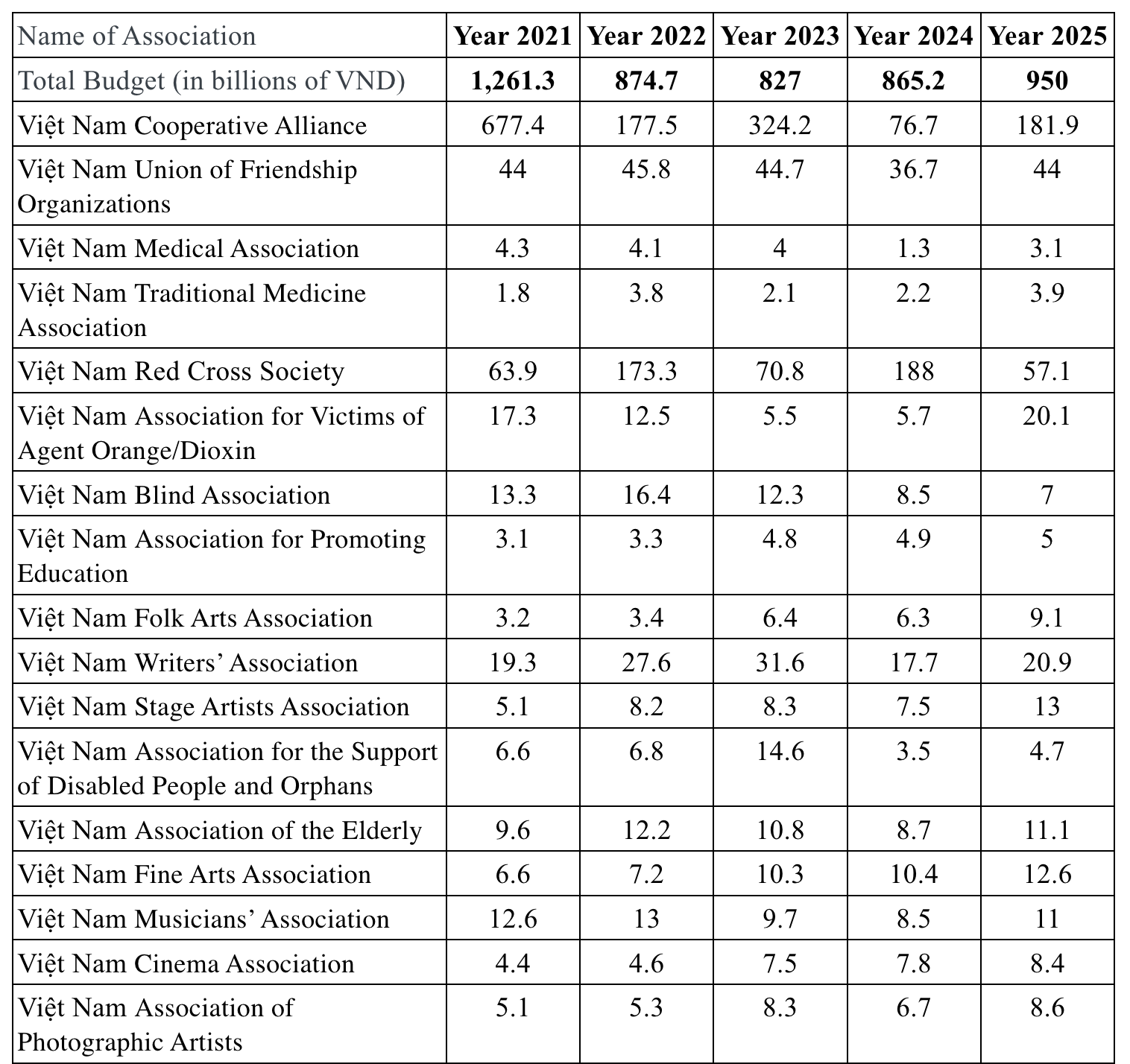
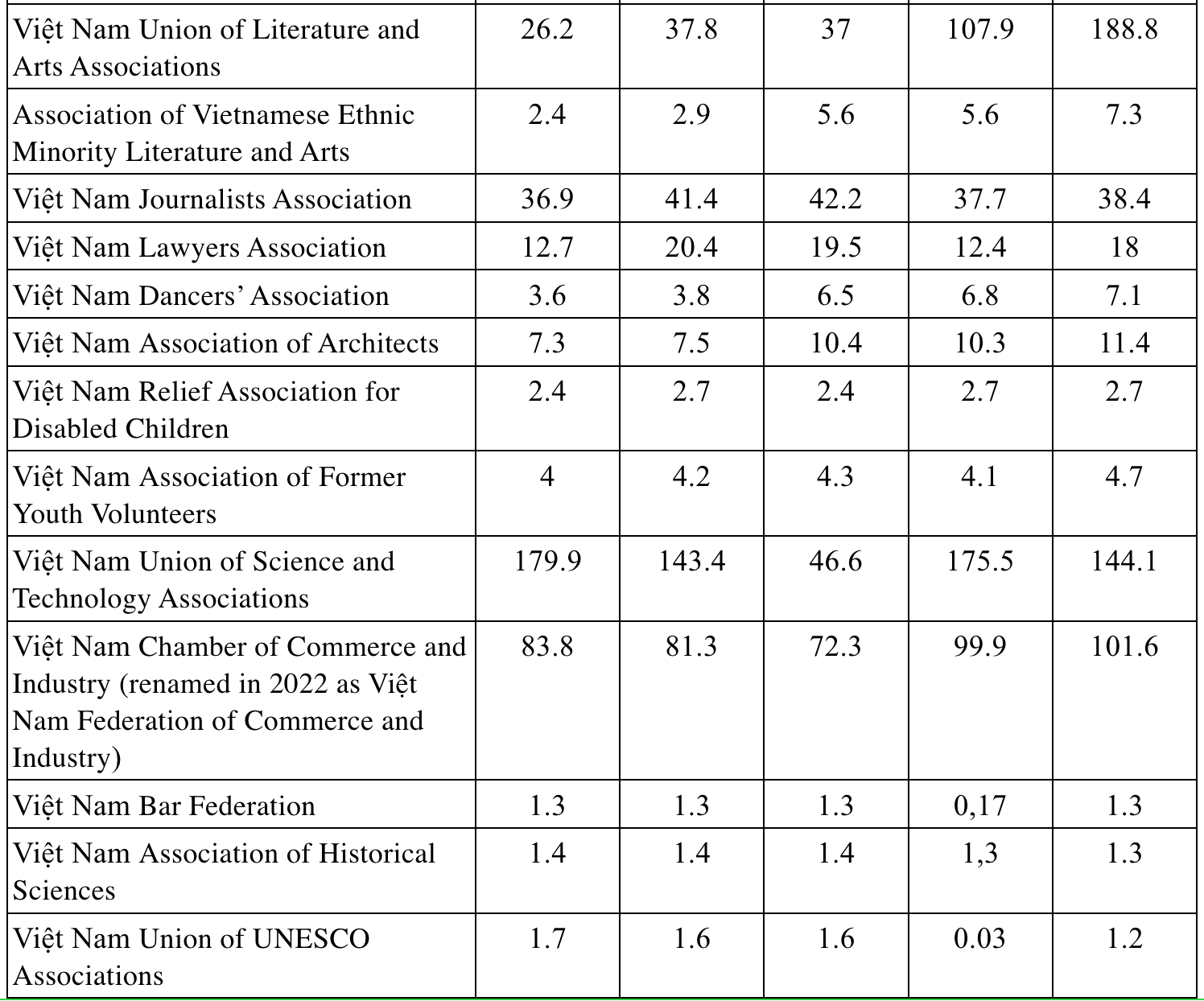
Beyond their annual budget, these associations generate revenue through membership fees and policy incentives.
Receiving Favorable Treatment
Although the six socio-political organizations and the other numerous associations serve as extended arms of the Party, the central government treats each of them differently and provides them with varying levels of support.
Budget Distribution
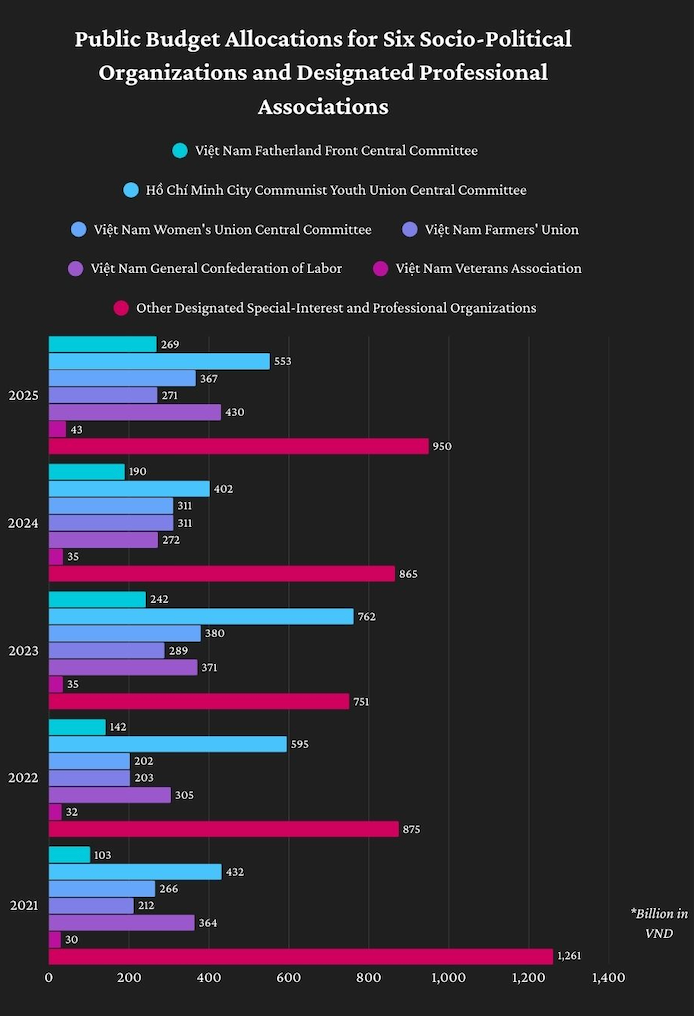
In 2025, the state has allocated a total budget of approximately 1.934 trillion VND to six socio-political organizations. Specifically:
- Việt Nam Fatherland Front Central Committee: 269.5 billion
- Hồ Chí Minh Communist Youth Union Central Committee: 552.7 billion
- Việt Nam Women’s Union Central Committee: 367.1 billion
- Việt Nam Farmers’ Union: 271.2 billion
- Việt Nam Veterans Association: 43 billion
- Việt Nam General Confederation of Labor: 430.5 billion
While the budget for special-status associations is around 950 billion VND, less than half of that amount is allotted to socio-political organizations.
Among socio-political organizations, the Hồ Chí Minh Communist Youth Union consistently receives the highest budget. From 2021 to 2025, its funding ranged from 431.6 billion to 762.6 billion VND annually. The Việt Nam Women’s Union is closely behind in budget allocation.
In contrast, the Việt Nam Fatherland Front Central Committee and the Việt Nam Veterans Association receive the lowest state budget.
As previously mentioned, the Việt Nam Publishing Association is the only one among the 30 mass associations that does not receive operational funding. In early 2024, this organization raised that issue in an appeal for support. However, the Việt Nam Union of UNESCO Associations appears—somewhat unexpectedly—on the list of organizations receiving annual state funding.
Staffing Allocations
Socio-political organizations operate at both central and local levels, with an estimated total workforce of around 80,000 people.
In 2022, the total staffing quota for the entire political system was over 2.2 million people for 2022–2026. Specifically:
- At the central level, Party agencies, the Việt Nam Fatherland Front, and socio-political organizations: 6,285 staff positions;
- At the local level: 64,266 positions;
- Socio-political organizations had a total of 70,551 staff positions nationwide
These personnel receive salaries from the state budget and are classified as officials, civil servants, or public employees. Additionally, they can be appointed to positions and titles within the Party and state agencies.
Lower Staffing for Special-Status Associations
While socio-political organizations have 70,551 staff, all special-status associations nationwide only employ around 5,000 personnel, including both official staff and allocated positions. Among these:
- 28 centrally-managed special-status associations: 686 staff positions
- Provincial level: approximately 80 staff positions
- District level: over 2,000 part-time personnel
- Commune level: varies with only a handful of staff members actively working
Special Privileges
Socio-political organizations enjoy significant privileges and often have other sources of revenue.

For example, the Việt Nam General Confederation of Labor — the central body of the Việt Nam Trade Union — owns and operates numerous hotels and guesthouses in prime locations across the country. These facilities offer competitive pricing and provide a substantial source of revenue for the trade union system. In the hospitality industry alone, they generate an estimated trillion VND in annual profit.
Some of their notable properties include:
- Việt Nam Trade Union Hotel (Hoàn Kiếm District, Hanoi)
- Hồ Chí Minh City Trade Union Guest House (District 1, Hồ Chí Minh City)
- Hạ Long Trade Union Hotel (Quảng Ninh)
At the local level, particularly in Hồ Chí Minh City, revenue from union fees and trade union funding has consistently exceeded their targets despite challenges such as the COVID-19 pandemic.
In 2021, the Hồ Chí Minh City Federation of Labor publicly disclosed total trade union financial revenues of 3.453 trillion, with over 2.432 trillion coming from the business and production sector.
In 2022, total trade union revenue reached 4.158 trillion, with 3.010 trillion coming from the business sector.
In 2024, the Federation projected total trade union revenue at 3.367 trillion.
The Effectiveness of Mass Organizations
The large budget allocation for socio-political organizations and special-status associations often raises concerns about their effectiveness and real-world impact. Over the years, many have asked, “Do these state associations truly bring clear benefits to society?”
This issue was raised during a 2016 National Assembly Standing Committee session. Nguyễn Thị Kim Ngân, the National Assembly Chairwoman then, stated: “Many deputy ministers retire, form an association, ask for offices, cars, budgets, and even staff positions. There are associations after others, but how many are effective?”
This system has become a victim of “state-ization” and “bureaucratization,” with many organizations formally operating and chasing achievements but failing to meet the real needs of the Vietnamese people. Many of these associations also have overlapping functions.
Another glaring issue is the system’s bulkiness and inflexibility. For instance, the Việt Nam Fatherland Front and the Mass Mobilization Commission maintain separate structures with different budgets, yet their tasks are quite similar. In fact, some localities even tried to combine these two organizations by appointing one person to lead both. This experiment failed due to inconsistencies in their operational mechanisms.
Regarding additional funding, Phạm Chi Lan, the former Vice-Chairperson of the Việt Nam Chamber of Commerce and Industry (VCCI), stated that these associations must be self-managed and financially accountable for their operations. According to her, these associations must fully control fundraising, sponsorships, and charging membership fees. The state should only provide funding based on clear, transparent criteria, based on competition and the effectiveness of each organization’s activities.
The Future of Socio-Political Organizations
Many local and central agencies have moved to merge or dissolve mass organizations in response to the government’s ongoing streamlining efforts. State-controlled media has also begun questioning whether budgetary support for these entities should be reduced or eliminated.
At the local level, on December 17, 2024, the Hà Giang Provincial People’s Committee decided to merge the Association of People with Disabilities and the Association of Victims of Agent Orange/Dioxin into the provincial Red Cross Association, consolidate the Literature and Arts Association into the Provincial Journalists Association, and dissolve the Provincial Gardening Association.
On December 26, 2024, the Quảng Bình Provincial Party Committee announced that it would cut the budgets for 20 mass organizations starting in 2026.
The Chairman of the Central Committee of the Việt Nam Fatherland Front, Đỗ Văn Chiến, declared that at least 46% of the agencies under the Việt Nam Fatherland Front and mass organizations at the central level would be cut.
Notably, socio-political organizations are also at risk of being dissolved in this ongoing “reorganization” of the administrative system.
According to Conclusion No. 127, on Feb. 26, 2025, the Politburo required the Party Committee of the Việt Nam Fatherland Front and other relevant agencies to study and develop a restructuring plan for the Việt Nam Fatherland Front, socio-political organizations, and mass organizations.
Following this directive, on March 4, 2025, in line with the current government’s streamlining, the Việt Nam Fatherland Front established a Standing Committee to overhaul its own structure, along with affiliated socio-political organizations and 30 mass organizations. The committee’s proposal is expected to be completed by April 7, 2025.

